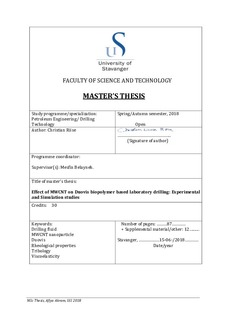| dc.description.abstract | In recent years, nanotechnology have shown an improving performance on the properties
of drilling fluid, enhanced oil recovery and in cement. The technology is proven in several
other industries. However, the research and development in the oil and gas industry is at
its early stage.
In this thesis work, several bases fluids have been formulated and the effect of MWCNT
on the bases fluids have been evaluated. The main investigation factors considered were
effect of pH, temperature and mixing condition. The bases fluid has been formulated by
mixing water, bentonite, Duouvis polymer, lignosulfonate and KCl. Nanoparticle based
drilling fluid have been formulated by adding 0.02wt%, 0.04wt%, 0.1wt% and 0.3wt%
MWCNT in the bases fluid. The performance of the drilling fluid have been evaluated
through simulation study.
Main results from the experiments and simulations are summarized as follows:
The effects of MWCNT on the bases fluid have shown impact on the rheological
properties, but the effect was non-linearly as concentration increases
Addition of 0.3wt% MWCNT decreased the friction coefficient by 43.6%
Higher pH increased the viscometer responses of the drilling fluid than the lower
pH. However, the rheological parameters are the same
As compared with the mechanical mixing, the ultrasonicated fluid increased the
YS and LSYS, but decreased the PV and the friction coefficient by 2.9 %
In general, the considered MWCNT concentrations have increased the filtrate loss
of the base fluid.
As compared with the base fluid, the viscometer readings of MWCNT treated
drilling fluids decreased less with increasing temperature
As the concentration of MWCNT increases, the storage and loss moduli are
increasing
The reduction of coefficient friction due 0.3wt% MWCNT allowed longer drilling
length
Except for 0.3wt% MWCNT system, the lower concentrations of MWCNT reduced
the PV as temperature increases. | nb_NO |
